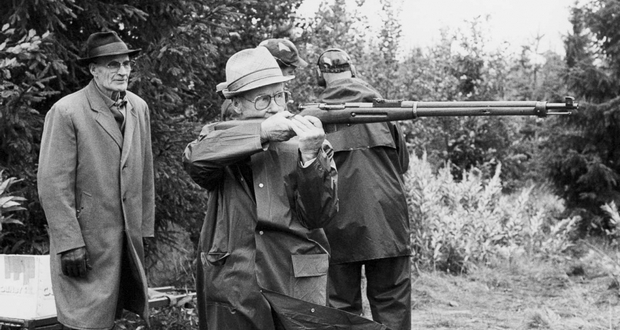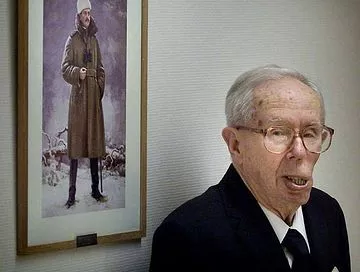A Note on Simo Häyhä: White Death
- Ankit Malhotra
- Jan 29, 2022
- 7 min read
Updated: Jan 30, 2022

In the winter of 1939, It's almost dark. A column of Soviet troops marches through a freezing terrain as the scarlet horizon extends across the vast, snow-draped woodlands. This is the Winter War, after all.
Talvisota, as the Finns name it, was Stalin's invasion of Finland. As the column moves forward, a flash appears out of nowhere, and a guy is knocked down. The Russian forces became immobile. "Sniper fire, get down!" is yelled, as the Russian forces fall to the ground and seek for cover, while another shot rings out and still another man is knocked unconscious. Among the concealing Russians, there is a murmur:
“Белая смерть” – The White Death.
A soldier wrapped head to toe in a snow-white coat balances his rifle on his gloves and calmly waits for another unfortunate man to accept his sights, obscured from view by the untamed scenery and snow heaped up all around him. But who is this mysterious figure who fills every Russian soldier in Finland with dread? Simo Häyhä, a natural hunter and sniper, was born and nurtured in the rough forests of Karelia in southern Finland. Häyhä credited his experiences as a farmer, hunter, and skier as an important component of his ability to become an exceptional sniper. From the age of seventeen, he served in the Finnish Civil Guard and Army, honing his marksmanship and winning shooting competition after competition. His home was said to be "packed with shooting trophies." Simo is sent to a garrison guarding the defence lines on the Finnish-Russian border when the war breaks out. Simo's commanding commander sees Häyhä's rifle skills in the early days of the battle orders him to work as a sharpshooter on his own. Häyhä's first operation as a sniper was a counter-sniping mission, ironically.
"It occurred once that my CO attempted to kill an enemy sniper with a scoped weapon," Simo said of the operation. This Russian had taken up position around 400 metres away from us and was firing at our lines all the time. After a time, he summoned me and showed me roughly where he believed the opposing sniper was stationed. When the duel started, one of our Lieutenants was with us, serving as a spotter. I couldn't find him at first, just a tiny rock where he was supposed to be. However, after a thorough search, we discovered him hidden behind a little mound of snow near that rock. With my trusty M/28-30, I took careful aim and the first shot struck the targeted target."
The Soviets were so afraid of Simo that they were ready to send in artillery to bomb the places where they suspected he was hiding. "The Russians put a lot of effort into attempting to murder me," Simo revealed. They began bombarding Simo's foxhole after finishing yet another Soviet sniper. "Fifty shells fell around my foxhole, yet none of them hit my foxhole." Simo had previously described. Despite their attempts, the Soviets only managed a scratch or, at most, a torn coat on Häyhä. Simo Häyhä's sniper methods are revolutionary at the time. Simo, unlike his Soviet predecessors, does not utilise scoped sights, preferring instead to employ iron sights since scopes might cause a sniper's position to be revealed. Due to the brilliance of their optics, he stated he captured numerous irresponsible Russian snipers. He is also unaffected by the cold since he is usually well-prepared with multiple layers of heavy winter apparel. Simo goes on a walk in the woods on a chilly December day and finds one of his favourite sites — a snow-covered tree with low hanging limbs that provides the ideal vantage point over a valley. With snow in his lips, he doesn't give away his whereabouts with his breath.
Häyhä piles snow around him to create a makeshift barrier, then sits and waits for hours with just a daily ration supply. Like any good hunter, he waits, waits, and waits... Until a group of four Soviet troops marches into the iron sights of his gun, rewarding his patience. Simo shoots and reloads quickly after each shot, and four men lie in the snow after four rounds, never to rise. Simo then fires his gun 25 times in one day, breaking the record for the most kills by a sniper in a single day. In the Soviet ranks, the legend of Simo Häyhä as the White Death is rising. Simo Häyhä's narrative as an unseen sniper and his legacy as "the terror of his opponents, a hero at home" frightened not only Soviet troops, but also the Soviet High Command, which placed a price on his head.
There were Soviet shooters who wanted the reward to go to the hotspots and were waiting for Simo in an ambush. One positioned himself and waited for hours. As darkness fell, the sharpshooter assumed Simo had departed and prepared to return to base. There's a crack in the wall. The Russian, on the other hand, never hears it and falls in the snow. Simo would reach 200 career kills by the end of January 1940, earning him a bespoke weapon made for him by the Finnish government, but he would continue to use his trusty M/28-30 rifle. Simo continues to rack up kills throughout the battle, culminating in an amazing achievement of nearly 500 sniper kills in less than 100 days.
He leads a group of Finns against a superior assaulting Red Army force aiming to break through the woodland in early March. Simo reminisced on the battle: "I was in Ulismaa's gloomy woodlands. One of several counterattack missions was assigned to us. Early in the morning, we moved to our starting positions. We were able to traverse a 300-meter-wide bog without issue. We charged at the adversary who was fairly close to us after we got over the marsh. My rifle performed well. We were so near to the enemy that some of them were no more than 2 metres away from me. The enemy was forced to retreat, but a few courageous troops lingered to wreak havoc on the rest of us. Suddenly, a shot was fired from around 50 to 100 metres distant, and I felt struck..."
Simo suffers tunnel vision after a whoosh, and then everything becomes white for the White Death, and he is struck in the mouth by an exploding bullet. Following the fight, the Finnish troops discover what they believe to be Simo's bones and lay him in a pile with the other dead. Then one of the Finns discovers a twitching leg in the midst of the heap. Simo was miraculously alive... but half of his face was missing. By the time he wakes up, he's been in a coma for three days, and the Winter War is ended. Simo had 26 procedures to replace his broken jaw, which was made from a portion of bone removed from his hip. Following his recovery, he spent the remainder of his days contentedly on his new farm in the picturesque Finnish countryside, dying away in 2002 at the ripe old age of 96. Simo left a history as the world's finest sniper and marksman, as well as a legendary Finnish hero.
Simo responded to a question regarding his wartime duty by saying:
"I didn't have any feelings for the enemy." I simply kept firing and loading as long as there were opponents around. I simply started shooting whenever I saw one. It didn't matter to me whether or not he was a commander. I'm fortunate in that I've never experienced a dream about the war. I've always slept well, even throughout the war. I did the best I could with what I was given."
When asked how he became so skilled at shooting, he simply said, "Practice."
Sources:
Lappalainen, Jukka-Pekka (6 December 2001). "Kollaa kesti, niin myös Simo Häyhä" [The Kollaa held out, so did Simo Häyhä]. Helsingin Sanomat (in Finnish). Helsinki. Retrieved 19 February 2011.
Rayment, Sean (30 April 2006). "The long view". The Daily Telegraph. London. Archived from the original on 12 January 2022. Retrieved 30 March 2009.
Saarelainen, Taipo (15 November 2016). "The White Death: History's Deadliest Sniper". Forces Network. Retrieved 21 February 2018.
Tapio A.M. Saarelainen: Sankarikorpraali Simo Häyhä (2006)
Kivimäki, Petri (14 March 2018). "Tutkijan kädet alkoivat vapista – maailmankuulun sotalegendan Simo Häyhän muistelmat löytyivät sattumalta". Yle.fi. Retrieved 14 March 2018.
Gilbert, Adrian (1996). Sniper: The Skills, the Weapons, and the Experiences. St. Martin's Press. p. 88. ISBN 0312957661.
Kivimäki, Petri (29 March 2017). "Sotalegenda Simo Häyhän ampumistaidot edelleen mallina nykypäivän tarkka-ampujakoulutuksessa". Yle Uutiset (in Finnish). Retrieved 25 July 2020.
Stahl, Michael (9 January 2020). "The Deadliest Marksman's Cold, Brave Stand". Narratively. Retrieved 2 July 2020.
William R. Trotter (2002) The Winter War: The Russo–Finnish War of 1939–40. Workman Publishing Company, New York (Aurum Press, London), First published 1991 in the United States under the title A Frozen Hell: The Russo–Finnish Winter War of 1939–40]. pp. 145–146
"Suuret Suomalaiset – 100 Suurinta suomalaista". 22 February 2011. Archived from the original on 22 February 2011. Retrieved 12 March 2019.
Jowett, Philip S. (2006). Finland at War, 1939–45. Osprey Publishing. pp. 44–45. ISBN 978-1841769691.
Pegler, Martin (2006). Out of Nowhere: A History of the Military Sniper. Osprey Publishing. p. 167. ISBN 978-1846031403.
Farey, Pat; Spicer, Mark (2009). Sniping: An Illustrated History. Zenith Press. pp. 117–118. ISBN 978-0760337172.
Simple History (15 February 2018), Simo Häyhä 'The White Death' (World's Deadliest Sniper), archived from the original on 18 November 2021, retrieved 8 April 2019
Stirling, Robert (2012). Special Forces Sniper Skills. Osprey Publishing. pp. 79–80. ISBN 978-1780960036.
Feist, Paul (2012). "The Winter War and a Winter Warrior". The Redwood Stumper 2010: The Newsletter of the Redwood Gun Club, Arcata, CA. Arcata, CA: Redwood Gun Club. p. 36. ISBN 978-1300039730.
Heldebro, Johanna. "Swedish artist Johanna Heldebro on her work "White Death"". artterritory. Retrieved 10 March 2014.
Sabaton – White Death (YouTube). 19 March 2019 [2010]. Archived from the original on 18 November 2021. Retrieved 13 July 2020.
Cannes 2012: Nicole Kidman Simo Häyhän seurassa rintamalka HBO-draamassa Hemingway & Gellhorn (in Finnish)
Arna Bontemps Hemenway (2019). "Wolves of Karelia". The Atlantic. Retrieved 28 September 2020.

















